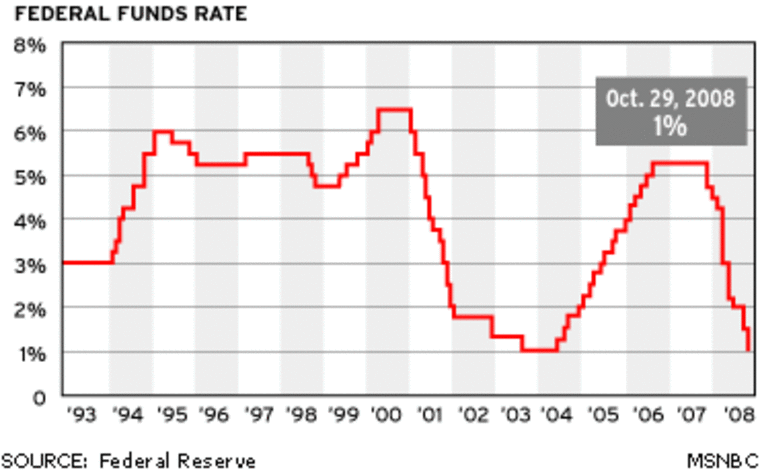The Federal Reserve Wednesday stuck to its playbook and left short-term interest rates where they have been since midyear, concluding that inflation is likely to slow as the economy continues to expand "at a moderate pace."
After a two-day meeting, the central bank's policymakers left the benchmark overnight federal funds rate unchanged at 5.25 percent, where it has stood since June 29, when the Fed halted a two-year rate-hike campaign aimed at keeping a lid on inflation.
Wednesday’s vote was nearly unanimous, with only one panel member, Jeffrey Lacker, saying he preferred another quarter-percentage point increase in the fed funds rate.
In comments released with the decision, the committee said that “economic growth has slowed over the course of the year, partly reflecting a cooling of the housing market" though it forecast continued expansion "at a moderate pace.”
Though they repeated their concern about high levels of inflation, the bankers said they expect price pressure to ease — thanks to lower energy prices and the Fed’s latest round of interest rate hikes, among other factors.
Stocks seesawed after the Fed announcement but mostly headed higher, with the Dow Jones industrial average ending up a scant 7 points, good enough for its 12th record close in the past 16 sessions.
“They have to talk tough on inflation when they’re not raising rates,” Robert McTeer, former president of the Dallas Federal Reserve bank, told CNBC. “So I think they’re going to stay where they are for quite awhile. I don’t see any change anytime soon in either direction.”
The decision about whether to raise rates again to fight inflation, the FOMC said, will depend on upcoming reports about the level of inflation and the strength of the economy.
Fed policymakers have stood on the sidelines for three straight meetings after raising rates a quarter-point at a time for 17 consecutive meetings dating to June 2004.
The Fed's move was announced hours after the National Association of Realtors said home sales fell for a sixth straight month and median prices fell by 2.5 percent, the biggest year-over-year drop on record. In its statement Wednesday the Fed reiterated that "a cooling of the housing market" is one of the factors behind the economy's sharply slowing growth.
The government's initial estimate of third-quarter growth is due Friday and is expected to show the economy grew at a tepid 2.2 percent pace in the third quarter, down from 2.6 percent in the second quarter and 5.6 percent in the first. Partly for that reason, the Fed has elected to stop raising rates, since higher interest rates can choke off business and consumer spending.
But central bankers are still concerned about inflation, which has been moving steadily higher after factoring out volatile energy prices. The current "core" inflation rate of 3 percent for consumer prices is well above the Fed's comfort level, which is 2 percent or less.
While economists, investors and other Fed watchers agree the central bank is committed to leaving interest rates alone for now, there’s a lot less agreement on what comes next.
Until recently, conventional wisdom held that the central bank's lengthening pause suggested that the next move, whenever it comes, would be to cut rates. Most Fed watchers believed that a slowing economy, led by a limping housing market, should help ease the Fed’s perennial worries about inflation and rates cuts would follow, probably sometime next year.
But with inflation still well above the central bankers’ comfort zone, the prospect of a rate cut seems to be moving further into the future.
“The economy is slowing, but the inflation data has still been stubborn and that's sort of a recipe for stagflation,” said Phil Orlando, chief equity market strategist at Federated Investors. “Right now we think the Fed is on hold, but we think that the people that expected the Fed to start cutting maybe by the end of this year, beginning of next — they may be a little disappointed."
Some now believe the next move may be upward, especially if a slowing economy doesn’t bring inflation down. Donald Straszheim, a long-time Fed watcher now at Roth Capital Partners, is among those who think the odds favor an increase in rates, which he says “the markets won’t like.”
Following is the full text of the statement issued by the Federal Reserve Wednesday:
The Federal Open Market Committee decided today to keep its target for the federal funds rate at 5-1/4 percent.
Economic growth has slowed over the course of the year, partly reflecting a cooling of the housing market. Going forward, the economy seems likely to expand at a moderate pace.
Readings on core inflation have been elevated, and the high level of resource utilization has the potential to sustain inflation pressures. However, inflation pressures seem likely to moderate over time, reflecting reduced impetus from energy prices, contained inflation expectations, and the cumulative effects of monetary policy actions and other factors restraining aggregate demand.
Nonetheless, the Committee judges that some inflation risks remain. The extent and timing of any additional firming that may be needed to address these risks will depend on the evolution of the outlook for both inflation and economic growth, as implied by incoming information.
Voting for the FOMC monetary policy action were: Ben S. Bernanke, Chairman; Timothy F. Geithner, Vice Chairman; Susan S. Bies; Donald L. Kohn; Randall S. Kroszner; Frederic S. Mishkin; Sandra Pianalto; William Poole; Kevin M. Warsh; and Janet L. Yellen. Voting against was Jeffrey M. Lacker, who preferred an increase of 25 basis points in the federal funds rate target at this meeting.
